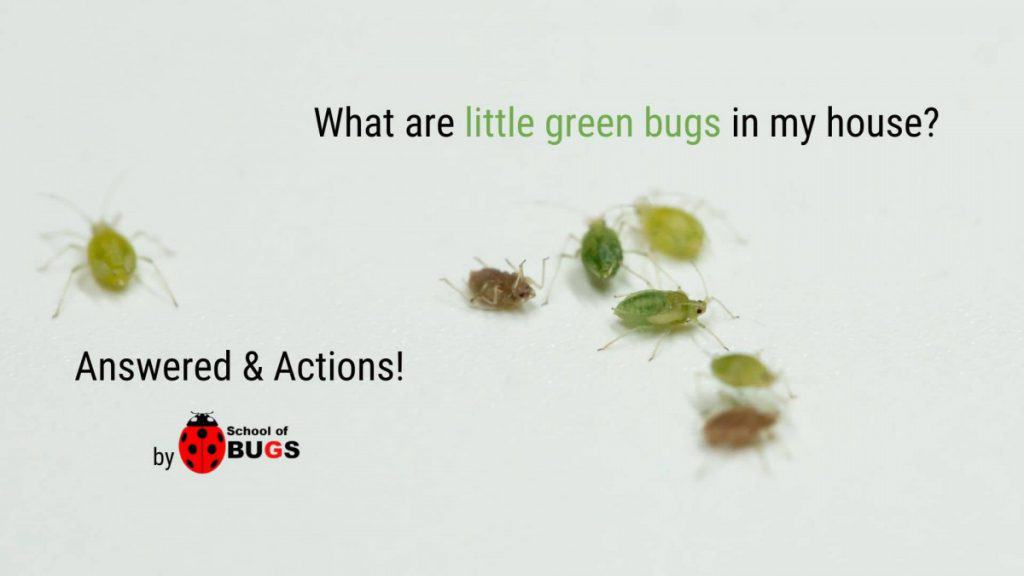As a homeowner, discovering tiny green bugs in your house can be annoying and a little unsettling. While some tiny green insects are harmless, others can cause damage to your home, possessions and even your health. This comprehensive guide will help you identify, prevent and get rid of tiny green bugs in the most effective ways.
What Are Tiny Green Bugs?
Tiny green bugs that infiltrate homes fall into one of three categories:
-
Aphids These soft-bodied pear-shaped bugs measure 1-10mm long. They congregate on stems and undersides of leaves, sucking sap from plants. Common houseplant aphids are green but also come in black white, red and pink.
-
Leafhoppers: Wedge-shaped bugs measuring 3-15mm long with hind legs suited for jumping. Leafhoppers cause minimal damage, just hopping to lights at night. Leafhopper species are green, brown or a mix.
-
Thrips Slender with fringed wings, thrips measure 1-2mm long They rasp and suck fluids from leaves and flowers leaving discolored blotches Common greenhouse thrips are bright green but can be yellow, dark brown or black.
Where Do They Come From?
Tiny green bugs can infiltrate your home from either indoors or outdoors:
-
Indoors: Houseplant pests like aphids reproduce rapidly, migrating between houseplants before establishing colonies. Bringing new infested plants indoors spreads bugs.
-
Outdoors: Leafhoppers blown inside on the wind are drawn to lights at night. Thrips from flowers and vegetables in your garden can be carried indoors on your clothes.
Greenhouse thrips and leafhoppers migrate far, invading homes without nearby greenery. But aphids spread via connected plant life like hedgerows.
Preventing Tiny Green Bug Infestations
Preventing tiny green bugs from infiltrating your home is more effective than eliminating existing infestations. Here are great prevention tips:
-
Inspect new plants thoroughly before bringing them indoors. Quarantine new plants for 1-2 weeks.
-
Check houseplants regularly, especially under leaves for bugs. Isolate infested plants immediately.
-
Apply insecticidal soap or neem oil to houseplants preventatively every 2-3 weeks.
-
Seal cracks around doors, windows and utility lines where bugs enter from outside.
-
Use bug zappers and fly screens to prevent migration indoors.
Keeping houseplants healthy with adequate sunlight, water and fertilizer makes them more resistant to pests. Maintaining cleanliness indoors and in your yard also discourages infestations.
How to Get Rid of Tiny Green Bugs
If tiny green bugs infiltrate your home, here are effective removal methods:
Non-Chemical Techniques
-
Shower houseplants with a strong jet of water to dislodge bugs, especially under leaves.
-
Apply rubbing alcohol to bugs using a cotton swab for isolated infestations. Avoid contact with plant leaves.
-
Sticky traps near plants capture green bugs flying indoors but won’t contain infestations alone.
Natural Insecticides
-
Insecticidal soap sprays smother soft-bodied green bugs like aphids. Reapply every 5-7 days.
-
Neem oil kills green bugs on contact and as a preventative. Spray plants thoroughly including undersides of leaves every 7-14 days.
-
Pyrethrin sprays derived from chrysanthemum flowers kill most tiny green bugs. Reapply weekly.
Chemical Insecticides
-
Systemic insecticides containing Imidacloprid are absorbed by plants, destroying bugs ingesting leaves. Not organic.
-
Contact insecticides with Malathion kill green bugs on touch, but can harm beneficial insects. Use cautiously indoors.
No matter the method, thoroughly treat infested plants including leaves, stems and soil to eliminate all tiny green bugs and eggs. Discard heavily infested plants if bugs persist after multiple treatments. Keep treating plants preventatively even after bugs are gone to prevent recurring infestations.
When to Call a Professional Exterminator
If you are unable to eradicate tiny green bugs yourself or identify unknown species, call a professional exterminator. Green bugs like aphids reproduce rapidly, so early intervention by experts improves success removing infestations. Professionals have access to strong chemical treatments that require proper handling and application. They also know how to target effective treatments for different tiny green bugs species while avoiding harm to humans, pets and beneficial garden insects.
Tiny Green Bug FAQs
Are tiny green bugs harmful to humans?
Most tiny green bugs like aphids, leafhoppers and thrips don’t bite or sting humans. But some people have allergic reactions to the substances emitted by squashed bugs. A few species can transmit plant diseases to garden crops.
What attracts tiny green bugs into homes?
Houseplant pests like aphids seek soft, tender growth to infest. Leafhoppers and thrips migrate inside via small openings seeking warmth and light. Flying to illuminated windows and lights draws them inside at night when outdoor temperatures drop.
Will tiny green bugs infest my home?
Some species like greenhouse thrips only inhabit gardens and won’t multiply indoors. But aphids reproduce rapidly on houseplants, spreading quickly from plant to plant. Getting rid of infested plants and preventing new bugs from entering keeps homes free of infestations.
How do I keep tiny green bugs off my houseplants?
Keep houseplants healthy and stress-free to fend off pests. Apply preventative insecticidal soap or neem oil treatments regularly. Remove heavily infested plants immediately before bugs spread. And isolate new plants before introducing to your existing indoor garden.

How to Identify Aphids
Are your plants covered with little green or white bugs? It could be the beginning of an aphid infestation. Heres how to identify, prevent, and control aphid infestations, so your plants stay happy and healthy!
Aphids are small, soft-bodied, pear-shaped insects that cluster densely on tender new growth and the undersides of leaves to suck plant juices. Plants often can withstand some aphid feeding with no adverse effect, but badly infested plants develop distorted growth and leaves may turn yellow or drop off.
Many species of aphids feed on home garden plants; these insects range in color from pale green, pink, or black to red or yellow. Size is typically 1/16″ to 1/4″. Adult aphids are generally wingless, but winged adults will appear when overcrowded. Immature aphids (nymphs) closely resemble adults.
Both adults and nymphs feed on a wide variety of both outdoor plants and houseplants, including most edibles and ornamentals. In small numbers aphids do little damage, but they are able to reproduce rapidly and can quickly become a more serious problem. Also, as they feed, aphids secrete a sweet fluid called honeydew that can attract ants; sooty black fungus may grow on coated leaves.
What to do when you have an aphid infestation Written by
Ive been gardening and writing about gardening for more than 20 years, yet I find Im always learning new things about the plants, insects and other critters that call my backyard home. Thats the great thing about gardening — its never boring! Ive worked as a landscaper, on an organic farm, as a research technician in a plant pathology lab and ran a small cut-flower business, all of which inform my garden writing. Someone once asked me when Ill be finished with my gardens, to which I replied, “Never!” For me, gardening is a process, not a goal. Horiculture review by
Maria Genovese is our staff Copywriter at Gardeners Supply. Maria holds an MA in Writing & Publishing from DePaul University—and her passion for gardening is just as strong as her writing skills. She recently worked as a Landscape Gardener at Mama’s Gardens in the Champlain Islands and completed the “Thriving Gardens” course through the Vermont Garden Network. She is participating in the University of Vermont Master Gardener program in 2025.
Last updated: March 27, 2025 | 2 min read
One of the most common plant pests, aphids tend to congregate on new growth where they suck plant juices and secrete sticky “honeydew.” These aphids are pale green; the white bits are the skins they left behind after molting. Aphids are common throughout the U.S.

